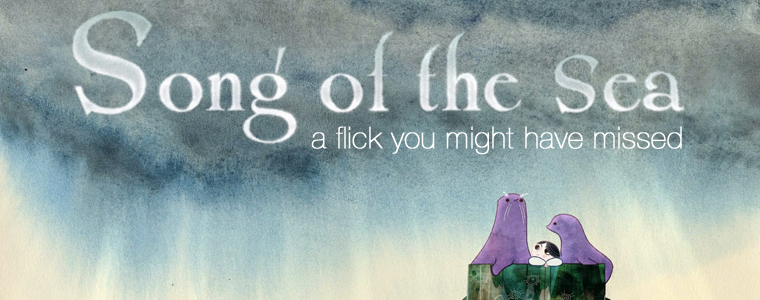Sea Versus Stone
by Andrew Collins
Plenty of cliché terms come to mind after watching director Tomm Moore’s Song of the Sea: enchanting, spellbinding, magical. Any would be accurate, but none quite do it justice. It belongs to that rare breed of films that draws from the deep well of tradition, myth, and heroism, but it presents itself on its own terms – a unique creation.
Moore and his Kilkenny, Ireland-based design/production house, Cartoon Saloon, follow-up their equally enchanting, The Secret of Kells, with another sweetly original film based on a Celtic myth — this time, the tradition of the selkie, creatures that transform from seals into humans when they shed their seal coat. Once they get their coat back, they return to the sea as seals. In the original mythology selkies can be quite devious creatures. When separated from their coat, they are bound by loyalty to the person who took it away from them, but they can be seductive and cruel when given the opportunity, as their allegiance always ultimately lies with the sea.
Song of the Sea takes a more childish (in the C.S. Lewis sense) approach to the myth, and the result is delightful. For 90 minutes, the myth of the selkie’s sea song becomes true, as the film’s traditionally drawn animation and soundtrack combine for an effect that is welcoming and ethereal. They draw out and stir the imagination, transporting the audience into a dreamlike world of magic and mystery behind the mundane trappings of modernity.
The success of this spell rises in no small part from the stunningly unconventional animation, which draws on the culture’s long tradition of geometric decoration, but with a confident modern flair for a magnificently realized and refreshingly non-Disney mise en scene.
The story begins on a small island off the Irish coast, where a young boy named Ben lives with his father and younger sister Saoirse (pronounced roughly seer-shə) in a lighthouse, their mother having passed away at the birth of Saoirse. Because he lost his mother, Ben is bitter and harsh with his sister, whom he appears to blame for her death.
Aside from Saoirse still being unable to speak at the age of six, they don’t seem too abnormal for a pair of siblings. But when Saoirse discovers a pure white coat in a chest next to a picture of her mother, it quickly becomes apparent that this voiceless child is an extraordinary girl representing an extraordinary hope. Mother’s bedtime stories are true! Here on All Hallows Eve, faeries lurk within the shrubbery of city roundabouts, seals return to dance in the sea off the Irish coast, slumbering giants from ages past stir, and ancient sages peer into the stories of the world from fathomless caverns.
But there’s a dark side. The magical world slumbers under the oppression of the witch Macha, who turns creatures to stone by taking away their feelings, and only the selkie’s song of the sea can restore them to life. The fate of all magical creatures hinges on a mute six-year-old, and her stubborn big brother. It’s basically the story of Harry Potter or Luke Skywalker all over again – except this time our underdog hero takes on the mysterious magical world with a retractable leash, 3D glasses, a hand-drawn map, and a trusty pooch.
This conflict between the magical world and Macha — over whether our emotions make life worth living — takes us to the very root of what it means to be human. We tell stories, after all, because we feel. Though Song of the Sea is nominally a children’s movie, this clash of philosophies lends complexity to the villain, who believes that stripping away anger and grief is a good thing – even an act of compassion. The problem, of course, is that in the process of removing the sadness, compassion and love get taken away too.
Grief is real – no getting around it. As Song of the Sea shows us, the sorrow of loss is part of the price of a meaningful life. Even the deepest magic cannot bring Ben and Saoirse’s mother back, but their sadness is not without hope. A magical restoration is at hand. It just takes the courage of a child.








